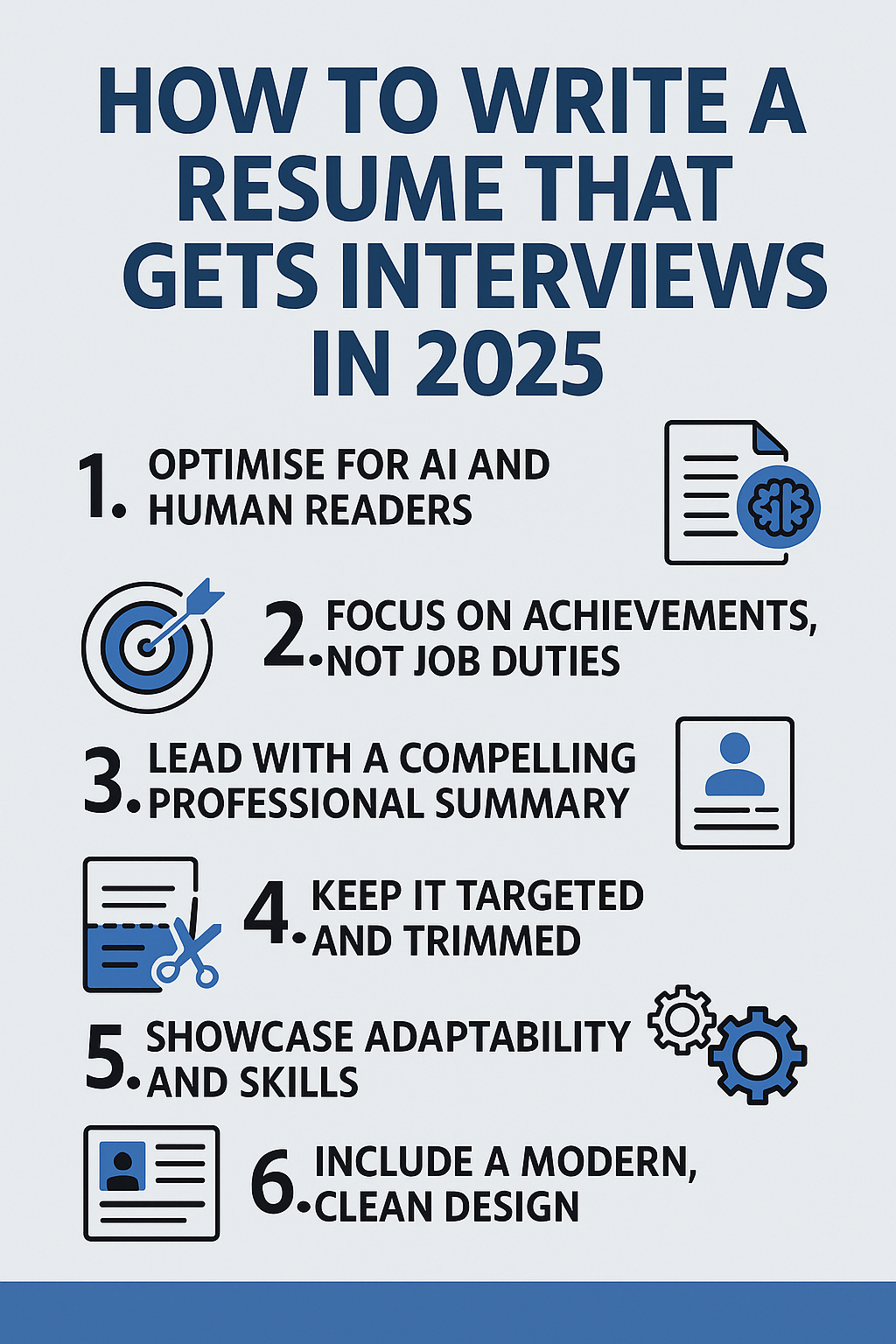
In 2025, employers are hiring faster but screening harder. Artificial Intelligence (AI) is now reading most applications before humans ever see them, and recruiters are sifting through hundreds of resumes per role. To stand out, your resume must do more than just “look good” — it needs to communicate impact, clarity, and credibility within seconds.
Whether you’re an executive, engineer, or recent graduate, here’s how to craft a resume that actually gets interviews in 2025.
1. Optimize for AI and Human Readers
Modern Applicant Tracking Systems (ATS) scan your resume for keywords, structure, and context. But once you pass the software gatekeeper, a human recruiter must still be impressed by what they see.
How to do it:
Use keywords directly from the job description (for example, “stakeholder management”, “service delivery”, “risk assessment”).
Avoid images, tables, or columns that can confuse ATS parsing.
Keep formatting clean and consistent with plenty of white space.
Use a professional font (Calibri, Cambria, Arial, or Helvetica).
The trick is finding the balance: simple enough for an ATS to read, yet polished enough to grab human attention.
2. Focus on Achievements, Not Job Duties
Listing responsibilities is one of the fastest ways to lose a recruiter’s interest. Every employer wants to know what difference you made — not just what you were asked to do.
Example:
❌ “Responsible for managing customer service team.”
✅ “Led a team of six to improve customer satisfaction scores from 78% to 92% within one year.”
Achievements show results. Duties show routine.
3. Lead with a Compelling Professional Summary
Your opening paragraph should act as your elevator pitch — not a biography. It should show who you are, what you offer, and why you stand out.
Example:
Results-driven Project Manager with eight years’ experience delivering infrastructure and digital transformation projects valued at over $10M. Recognised for stakeholder engagement and process improvement across NSW Government and Tier 1 contractors.
Avoid generic statements like “hardworking professional” or “team player”. Everyone says that. Lead with measurable outcomes or areas of expertise instead.
4. Keep It Targeted and Trimmed
Recruiters skim, not read. If your resume exceeds two or three pages (except for academic or medical roles), you risk losing the reader before they reach your highlights.
How to streamline:
Focus on the last 10–15 years of experience.
Drop outdated or irrelevant roles.
Replace long paragraphs with sharp bullet points.
Prioritise relevance over chronology.
Remember: a resume isn’t your life story — it’s your marketing brochure.
5. Showcase Adaptability and Skills for the Future
In 2025, employers are prioritising digital fluency, problem-solving, and adaptability. Highlight skills that prove you can thrive in a changing workplace.
High-demand skills to feature:
Data literacy and analytics
AI or automation awareness (even at a basic level)
Collaboration and stakeholder communication
Project delivery and continuous improvement
Compliance, safety, and sustainability practices
If you’ve completed recent micro-credentials, training, or certifications, include them. They show initiative and up-to-date knowledge.
6. Include a Modern, Clean Design
Visual appeal matters — but don’t overdo it. Avoid cluttered templates or graphics that distract from content. A simple, elegant layout with consistent spacing and strong section headings makes your resume feel current and professional.
If you’re unsure how your resume looks against today’s standards, you can compare yours to ATS-optimised designs from Crisp Resumes. Their templates balance readability with impact and meet 2025 recruitment standards.
7. Proofread Like Your Career Depends On It (Because It Does)
Typos, spacing errors, and inconsistent dates are deal-breakers. Before sending your resume, print it, read it aloud, and run it through a professional editor or grammar tool. A second set of eyes — ideally from a career professional — can spot what you miss.
Final Word
The job market in 2025 rewards clarity, authenticity, and evidence of value. A great resume doesn’t just describe your career; it positions you as the solution to an employer’s problem.
If you’re struggling to turn your experience into interviews, consider a professional rewrite. At Crisp Resumes, we help Australians create resumes that combine strategy, storytelling, and ATS performance — so you can get noticed faster and interview with confidence.
Write a comment ...